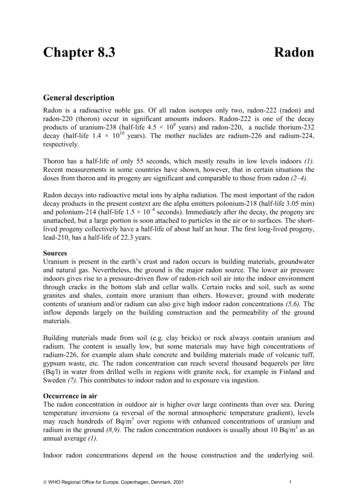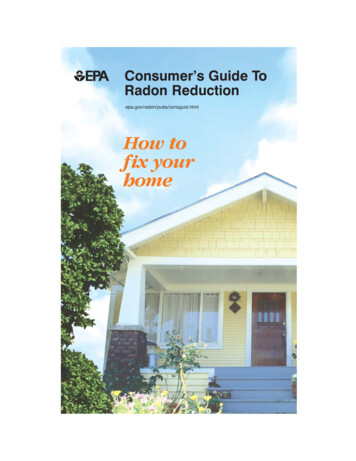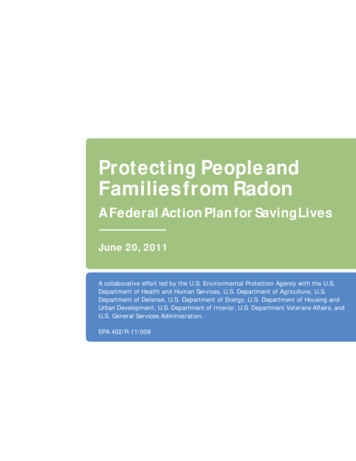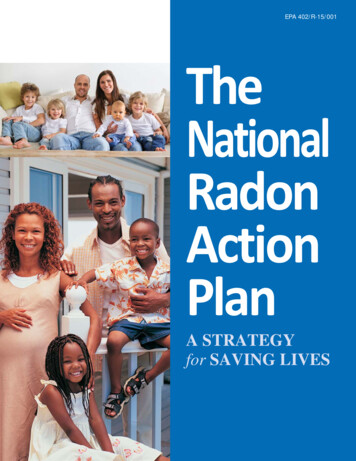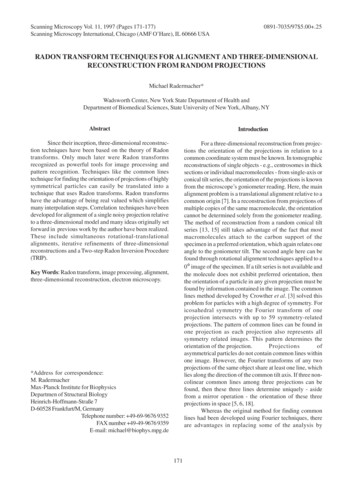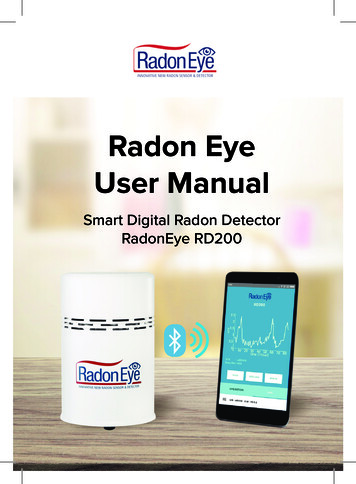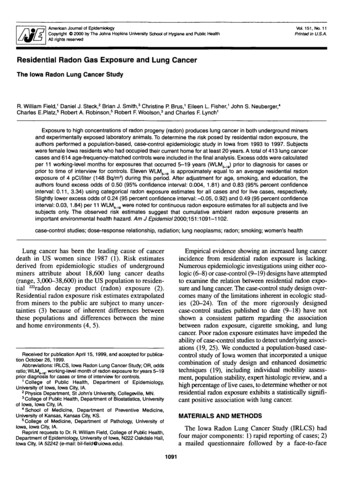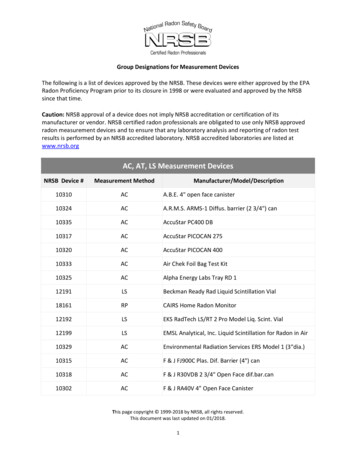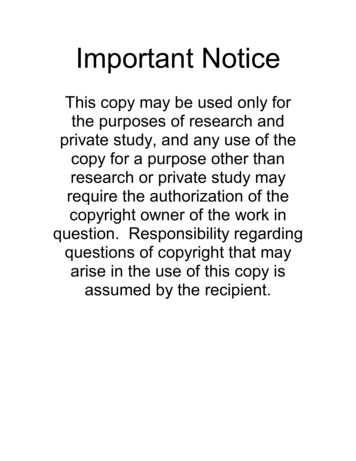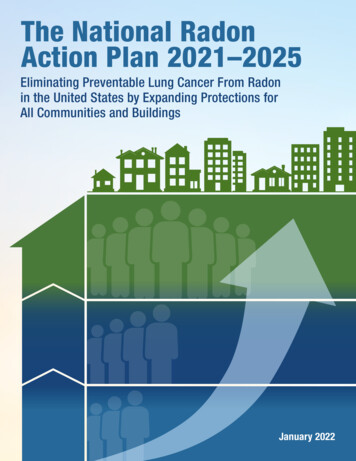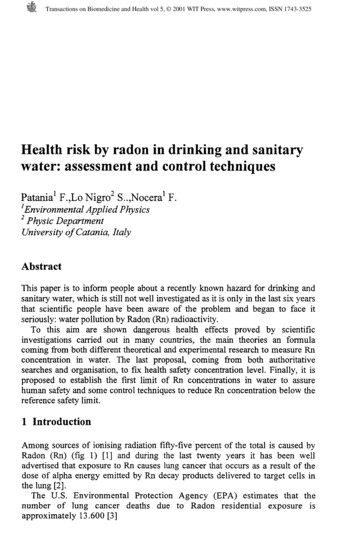
Transcription
Transactions on Biomedicine and Health vol 5, 2001 WIT Press, www.witpress.com, ISSN 1743-3525Health risk by radon in drinking and sanitarywater: assessment and control techniques atania'F.,Lo i g - S.0., ocera' F.' nvironmentalApplied PhysicsPhysic DepartmentUniversity of Catania, Italy2AbstractThis paper is to inform people about a recently known hazard for drinking andsanitary water, which is still not well investigated as it is only in the last six yearsthat scientific people have been aware of the problem and began to face itseriously: water pollution by Radon (Rn)radioactivity.To this aim are shown dangerous health effects proved by scientificinvestigations carried out in many countries, the main theories an formulacoming from both different theoretical and experimental research to measure Rnconcentration in water. The last proposal, coming from both authoritativesearches and organisation, to fm health safety concentration level. Finally, it isproposed to establish the first limit of Rn concentrations in water to assurehuman safety and some control techniques to reduce Rn concentration below thereference safety limit.1 IntroductionAmong sources of ionising radiation fifty-five percent of the total is caused byRadon (Rn) (fig 1) [l] and during the last twenty years it has been welladvertised that exposure to Rn causes lung cancer that occurs as a result of thedose of alpha energy emitted by Rn decay products delivered to target cells inthe lung [2].The U.S. Environmental Protection Agency (EPA) estimates that thenumber of lung cancer deaths due to Radon residential exposure isapproximately 13.600 [3]
Transactions on Biomedicine and Health vol 5, 2001 WIT Press, www.witpress.com, ISSN 1743-3525114Environmental Health RiskINTERNAL 11%( n s d e Human Body)Jd[X"a,"M scellaneoushLzlArFuel Cycle 00 11%%\.Figure 1: Sources of Radiation ExposureRadon is the heaviest mono-atomic gas and there are three isotopes of atomicweight 219, 220, 222. The gas is both colourless and odourless so it presents asly behaviour for human health, in fact people discovers its presence only afterhave suffered heavy health damage [4].2'2Rn, the isotope of main concern, is produced by radioactive decay of Radiumwhich, in turn, is a radioactive product of uranium.Sources of Rn include soil, water, outdoor air and buildings materials andsince Radium is widely distributed in earth's crust it is found in mineral thatcome in contact with underground water. In this way Rn, which is soluble inwater, is found in ground water too and in some cases significant concentrationshave been observed [5]The concentration appears to depend upon the structure of the aquifer and thedistribution of the Radium in the rock matrix.In many cases, the concentration of Rn in water are "unsupported", meaning thatthere is relatively little Radium dissolved in the water giving rise to the Rn that israther transferred into the water directly from the radioactive decay of theRadium in the solid materials in the aquifer.Through research results people can have main formulas to measure Rn bothin underground water and in drinking and sanitary water, Rn concentration thatcan cause health risks and some control technics too to reduce the risk for humanhealth.2 Radon in the waterWith reference to Rn in underground water, the main data estimating the naturalconcentration in presence of radioactive rocks has been done by formula (1) [6]which gave the distribution of the Rn released at water rock interface into thewater flowing as following:
Transactions on Biomedicine and Health vol 5, 2001 WIT Press, www.witpress.com, ISSN 1743-3525Environmental Health Risk115(1)Where:r density of rock;A ratio of Rn released into water to Rn generated in the rockRa activity both of uranium and Radium contents of the rockf fractional pore space of the rockX distance covered with the aquifer;v transport velocity of water after leaving the aquiferIf people knows hydrodynamic parameters of aquifer and both the pore sizedistribution and mineral composition of the rock formula (1) may estimate,sufficiently to our purposes, the concentration of Rn contents in common aquifer.Of course the increase of Rn concentration in water it is function of time too, asshown by following formula:6C Q67 - h C 6 (2)where:C Rn concentrationQ units of atom entering the water per unit of timeh decay constant of RnT timeIf peoples integrates equation (2) for 7 h,that is quite stationary liquid, the Rnconcentration is given by the supply and decay rate.It's developed [6] also following formula to estimate Rn concentration in naturalfluid:where:C activity of Rn concentrationE Rn flux emanating from the rockh decay constant of Rncp porosity of the rockr, radius of cylindrical fracture in the rock of height hr, radius of circular ring of rock which comprises the r, fracture from whichRn diffuses into the ffactureQ flow rate.As Rn gas is moderately soluble in water with which forms, by means of VanDer Waals forces, structures of Rn6 H20 type, that is clathrates [7], it is evident
Transactions on Biomedicine and Health vol 5, 2001 WIT Press, www.witpress.com, ISSN 1743-35251 16 Environmental Health Riskthat the atom of Rn are polarised by the strong dipole of the water molecule. Ifph values of water increase clathrates are destabilized with consequenttransformation of Rn from liquid to gas phase [S].Moreover, in the case of turbulent water flow with presence of gas bubbles inthe aquifer, the transport of Rn atoms is due to their capacity to attachthemselves to the bubbles of carrier gas [9].If the energy amount of Rn in the interface Rn-bubble is minor than that of theisotope in water, Rn is carried by the bubbles at the velocity of same bubbles.People can see that coming from laminar water flow to high turbulent flow, thatis the flow with very high numbers of bubbles per unit of volume of water, theRn concentration can be changed by degassing of liquid phase. It is well knowtoo that solubility of Rn in water depends on water temperature: the colder thewater greater is the solubility of Rn, as it is not so easy to characterise Rnsolubized in each point of aquifer and than to calculate its concentration in wateras there can be different both geological and flow-dynamical situations duringthe extent of the same aquifer.The above showed formulas can give, to our purposes, only as very generalrole information about Rn concentration in the underground water and the sameinformation can change during the course of year by changing of level of watercreek. For all above said reasons it is in our opinion that the best way to knowRn concentration in water coming from subsoil it is to execute someexperimental measurements, at least three or four times per year, really in thedrawing points of sources of water supply as like as artesian wells, springs,lakes, water reservoirs and so on. Only after verifying during a significant timeperiod, at least two o three years, that Rn in water has not health dangerouslevels concentration than could be possible to reduce surveillance at one controlmeasurement per year.With reference, finally, to indoor use water, particularly in circumstanceswhere the water is heated or aired such as in a shower or laundry, it happensreleasing of Rn from water into the indoor air. The amount of Rn released perunit of Rn dissolved in the water depends upon water use rate for each kind ofuse and upon the efficiency is referred as transfer coefficient (tab. 1).Table 1: Transfer CoefficientWater useTransfer coefficientDish - washerLaundryShowerBathtubeWC0.95 - 0.900.92 - 0.880.76 - 0.660.42 - 0.3 80.34 - 0.22Data on these parameters can be used to estimate the average contribution fromwater use to indoor airborne Rn concentration [l01 by formula (4):
Transactions on Biomedicine and Health vol 5, 2001 WIT Press, www.witpress.com, ISSN 1743-3525Environmental Health Risk117where:S, activity per time unit of indoor Rn concentration coming fiom water;V volumeC, activity per time unit of Rn concentration in waterei transfer coefficient function of kind use.yields the steadyDividing each side of formula (4) by the ventilation rate (L),state air concentration (Ca).The overall ratio of air to water Rn concentration can be estimated by formula(5):where:W total per capita water use ratee use weighted transfer coefficient.On average, almost complete transfer of Rn fiom water to air occurs when bothheath and aeration or agitation are involved such as in a dish-washer or laundry.3 Radon measurementsRn is moderately soluble in water and its solubility depends on watertemperature: the colder the water greater is the Rn solubility. To measuresolubility in water is used the solubility coefficient defined as the ratio of Rnconcentration in water to that in air.As at 20 C the solubility coefficient is about 0.25, it means that Rn isdistributed preferentially in air rather than in water in the ratio 4: 1.By this ownership Rn in water can be easily measured after its extraction bybubbling air through the water or by extracting Rn from the water by organicliquid scintillators [l l ]These kinds of measures can be referred only to a small sample of water, suchas a very little reservoir, and to a particular time of sampling. But in the case ofaquifer or artesian wells, or water creeks, the Rn distribution into the water maybe not constant throughout the entire volume because there are many possibilitiesof big variations of Rn concentration in the water both during the time and indifferent positions in function of the parameters showed previously.It is studied the absorption of radiogenic gasses in different polymers and sincepolyethylene is characterised by a certain solubility coefficient it may absorb Rnwhich can be measured at the end of exposure by y- spectrometry.This techniques offers advantages to have possibility both to integrate Rnconcentration over time and water volume and to measure Rn at any places of
Transactions on Biomedicine and Health vol 5, 2001 WIT Press, www.witpress.com, ISSN 1743-35251l 8Environmental Health Riskwater volume, as like as in aquifers or big reservoir, by inserting in checkedzones polyethylene foils direct in water.However, there are many techniques to measure Rn concentration in water assuch the analysis of the Rn daughters in equilibrium with the water and ycounting detector used to measure the Rn concentration of water samples comingfrom detected source and collected in polyethylene or lucite modified Marinellibeakers [13].For all above techniques it is necessary to have a very good care in handlingand in carrying samples to prevent outgassing of Rn during both the process ofcollection and transport or storage.A method more simple and not 'expensive is that one to use in situ passivedetector as Alpha track detectors.The device is an a-track monitor inside a plastic container placed inside thewater [13].To relate the air Rn concentration in the container and that one in the water isused an empirically derived constant and manufacturers of devices assure thataccuracy of measurements is better than It 10% of error.4 Health risk concentrationRadon in drinking or sanitary water presents main two kind of health risks: thatone caused by inhalation of Rn holder into the water and the other one caused byingestion of polluted water: the inhalation causes lung cancer and ingestioncauses stomach cancer.With reference to inhaled Rn, that is Rn coming fiom the water into indoor air,there is not one furing and official value of concentration because health limithas fixed in different ways by different Organisations: U.S. EnvironmentalProtection Agency (EPA) gave the limit of 150 Bq/m3 , CEE - Euratom gave thelimits of 200 Bq/m3 in new buildings and 400 Bq/m3 in old existing building,International Commission of Radiological Protection (ICPR) gives one limitrange between 200 and 600 Bq/m3 .Italy has no regulation on exposure to Rn in air concentration.On the ground of results coming fiom National Radon Survey 1141, whichshowed that about 1% of Italian dwellings have an annual average Rnconcentration above 400 Bq/m3 and about 5% higher than 200, twohypothesis were outlined by two Italian research groups [IS] coming fromEnvironmental Protection Agency and the National Institute of Health respectly.The first of one hypothesis was to adopt 400single reference level, whilethe other one was a first step to be taken at the National Level Authority bypermitting a range of values between 200 and 400 Bq/m3 and the final decisionof value, within the previously range, attributed to decision of RegionalAuthority in function of the importance of the Rn problem, the social andeconomic costs of choiced limit and health priorities.About this matter in 1996 has started, under the sponsorship of DirectorateGeneral for Science, an European Research into Radon in Construction
Transactions on Biomedicine and Health vol 5, 2001 WIT Press, www.witpress.com, ISSN 1743-3525Environmental Health Risk119Concerted Action (ERRICCA) with the go1 to develop a draft for an Europeanregulation to be presented to European Commission.With reference to limit concentration in indoor air, even if there are not yetofficial ERRICCA suggestions, it seems that safety limit could oscillate between150 and 250 Bq/m3.However, based on estimates of the distribution for each of the fourparameters in formula (5), the distribution for the overall transfer factor "f" canbe estimated to have a geometric standard deviation of 2.88 and an average of1.4*104 [IO].The results indicate that, on average a Rn concentration of 10.000 Bq/m3 isneeded to in order to yield an indoor air concentration of 1.0 due/ to muse indoor of polluted water [ l 61On the ground of above information people can see that probability to havesignificant indoor air Rn concentration coming fiom use of polluted water isquite small as some dangerous effects may start only for Rn concentration in thewater up to 1OO* 104Bq/m3With reference to ingestion of polluted water, as Rn solubilized in the water isintroduced entirely in the human body it is logical conclusion that all y-radiationsemitted by Rn will hit digestive apparatus therefore is in our opinion that 100Bq/m3 concentration may be adopted as health limit concentration. Of course thisis only an indicative safety dose because the risk coming from ingestion ofpolluted water depends also by somatic condition of people, as for 100 Bq/m3 ofRn concentration people have different levels of risk between grow-up personsand infant, between sound and sick people and so on.5 Remedial action and control techniquesOmitting the well known remedies for indoor air Rn [l71 and with reference onlyto ingestion of Rn polluted water, there are three main techniques to reduce Rnconcentration as following:Increasing water temperature such as to decrease Rn solubility which isinverse function of temperature. This way is rather limited by heating coststhat are direct function both of initial water temperature and of volume.Increasing in the water ph rate (7 10) such as to decrease strong dipole ofwater molecule which polarise the atoms of Rn in clathrates (Rn6H20) thatare destabilized by ph increasing with the consequent passage of Rn fromliquid to gas phase outdoor of water. This way is limited by ph rangenecessary to have drinking water. To reduce final ph rate after this processpeople can mix the high ph rate water with no polluted low ph rate waterDegasing polluted water by insufflation in many points of its volume withhigh pressure air such as to cause both very turbulence water flow and manyair bubbles high velocity flow into the water. The transport of Rn atomsoutdoor water is due to their capability to cling themselves to bubble ofcarrier gas. If the energy degree of Rn at the Rn-bubbles interfaces is lessthan that of the same Rn in the water, pollutant is inclined to be carried out
Transactions on Biomedicine and Health vol 5, 2001 WIT Press, www.witpress.com, ISSN 1743-3525120 Environmental Health Riskby growing up bubbles at their velocity [IS]. This tecnichs offers bothbigger efficiency and lower costs than the previously ones.When Rn concentration in water is quite elevated all three way may be used insequence as shown in fig.2@MEASUREMENT STATIONCF Rn CONCENTRATION@DEGASING RESERVOIR@ELOWING ENGINE@Fh VARIATION VESSEL(5)BLENDING TANK@HEATING TANK-4C1,/DRINKINGAND SANITARYUSE/ WATER FLOWRn CONCENTRATION (Bq/mc)AGRICOLTIIRAL ANDINDUSTRIAL USEFigure 2: Control Actions to Reduce Rn concentration in waterConclusionFor that said above, it is verified that there are many possibilities to have healthdangerous Rn concentration in underground water and it is also proved that Rn inthe water causes risks of cancer when people utilise such polluted water fordrinking and sanitary use. The health hazard is worse since Rn presence in thewater, like that in the air, is perceptible only after radioactive measurements.There are a lot of control tests provided for by law before people can utilisewater for drinkable uses, but no tests refer to the radioactive hazard. Therefore, itis our opinion that this must be carried into effect by National or EuropeanAuthorities the same actions of hazard assessment, that is:Waction to advertise that Rn in the water can represent big hazard for humanhealth;action to fix, by results of researches, official maximum reference value ofRn concentration in drinkable or sanitary water;investigatory action on national sources of drinking water to control thatlevel of Rn concentration is minor than that fixed for health safety;Wactions of subdivision of Rn concentration exceeding safety reference limitin some intervals, for example from 100 to 200, from 200 to 300
Transactions on Biomedicine and Health vol 5, 2001 WIT Press, www.witpress.com, ISSN 1743-3525Environmental Health Risk121 and/ upm300 , with/ mthe aim to assign the priority of publicremedial intervention, in function of interval value.References[l]- National Council on Protection and Measurements (1987). IonisingRadiation Exposure of the Population of the United Stated, NCRP Report 93,Bethesda MD.[2] Patania F., Gagliano A., (1994). Radon Secret and Detrimental Effect onIndoor Health, Proc. of 2th International Conference Cold Climate HVAC,March 1994, Rowaniemy, Finland.[3] U.S: Environmental Protection Agency (1992). A Citizen's Guide to Radon,EPA 402 - K92 -00 1, Washington, DC.[4] Patania, F. (1995). Origini Patologie e Control10 dell'inquinamento da Radon.In: Condizionamento dell'Aria e Refrigerazione, vol. 12, pp. 1161-1 168 andvo1.13, pp.1247-1255.[5] Laurence, E.P., Wanty, R.B:, and Nyberg, P. (1992). In: Contribution of2 2 2 inn Domestic water Supplies to 2 2 2 inn Indoor Air in Colorado Homes,Health Physics, vo1.62, pp 171-177.[6] Stoker, A. And Kruger, P. (1975). Radon in Geothermal Reservoirs, Proc. Of2th UN Symposium on Development and Use of Geothermal Resources, SanFrancisco (USA).[7] Nesmeyanov, An.N. (1974). Radiochemistry, Mir Publisher, Moscow.[S] Gasparini, P. And Veltri, C. (1987). Radon: un Precursore dei Terremoti?,Aree Sismogenesiche e Rischio Sismico in Italia, Eds. Boschi, E. And Dragoni,M. Pp. 585-609.[9] Kristiansson, K. And Malrnqvist, L. (1982). Evidence for Non diffusiveTransport of Radon in the Ground and a New Physical Model for the transport,Geophysics, vol. 47 pp.1444-1452.[l01 Nararof, W., Doyle, s.M:, Nero, A.V. and Sextro, R.G. (1987) .Potablewater as source of Airborne 2 2 2 inn U.S. Dwellings: A Review and Assessment,Health Physics, vol. 52, pp.281-295.[l11 Countess, R.J. (1978). Measurements of Radon-222 in Water, HealthPhysics, vo1.34, pp.390-396.[l21 Labed, V. (1991). "Etude de la Permeation du Radon a Travers lesMembranes Plastiques. Application a une Method de Measure du Radon dal1'Eau el les Sols Satures. France: Brest University. Ph.D. Dissertation. ReportCEA-R-55-880 CEN Saclay.[l31 Prichard, H.M., and Gesell, T., (1997) Rapid Measurements of Radon-222Concentration in water with a Commercial Liquid Scintillation Counter, HealthPhysics, Vol. 133 pp. 577-586.[l41 Bochicchio, F., Carnpos Venuti, G. , Nuccetelli, C., Piermattei, S., Risica,S., Tommasino, L. and Torri, G. (1995). Scenario of Radon Indoors in Italy andRegulation Policy, Proc. Healthy Buildings 95, Milano 10-14 September 1995.Ed. M. Maroni vol. 2, pp.653-663.
Transactions on Biomedicine and Health vol 5, 2001 WIT Press, www.witpress.com, ISSN 1743-3525122 Environmental Health Risk[l51 Bochicchio, F., Carnpos Venuti, G. , Nuccetelli, C., Piermattei, S., Risica,S., Tommasino, L. and Torri, G. (1995). Results of the Representative ItalianNational Survey on Radon Indoor, Healthy Physics, vol. 71 pp.741-748.[l61 Lawrence E.P., Want, R.B: and Nyberg, P. (1992). Contribution of " ' n inIndoor Air in Colorado Homes, Healthy Physics, vol. 62 pp. 171-177.[l71 Scivyer, C. and Woolliscroft, M. (1998). Radiation Remediation andProtective Measures in UK Buildings: the Work of the Building ResearchEstablishment Ltd , UK Nuclear Technology Publishing, Radiation ProtectionDosimetry, vol. 78, pp.39-44.[l81 Grarnmakov, A.G: (1936).0n the Influence of Some factors in theSpreading of Radioactive Emanation Under Natural Conditions , Zhur Geafiz,vol. 6 , pp. 123-148
distribution of the Radium in the rock matrix. In many cases, the concentration of Rn in water are "unsupported", meaning that there is relatively little Radium dissolved in the water giving rise to the Rn that is rather transferred into the water directly from the radioactive decay of the Radium in the solid materials in the aquifer.
